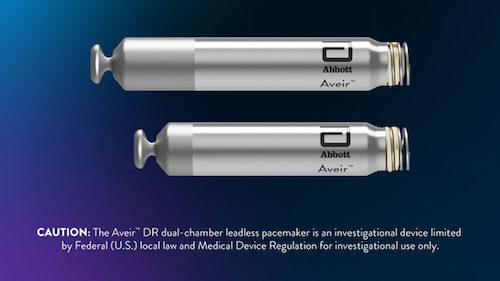
February 8, 2022 – Abbott announced the world’s first patient implants of a dual-chamber leadless pacemaker system as part of its AVEIR DR i2i™ pivotal clinical study. The implant of Abbott’s investigational Aveir™ dual-chamber leadless pacemaker represents a significant technological milestone for leadless pacing technology and is the first to occur around the world within the pivotal trial.
People who experience a slower-than-normal heart rate may receive a pacemaker — a small battery-powered device implanted in the chest that delivers electrical impulses via thin insulated wires, called cardiac leads, that cause the heart muscle chambers to contract to help restore a normal heart rhythm. Unlike traditional pacemakers, leadless pacemakers are implanted directly into the heart through a minimally invasive catheter-based procedure and eliminate the need for cardiac leads. While leadless pacemakers work like traditional pacemakers to regulate heart rate, they offer reduced lead-related complications and a less restrictive recovery period due to the minimally invasive implant procedure. Yet historically, leadless pacing options have been limited to single-chamber devices because synchronization of two leadless pacemakers has been highly difficult to achieve.
Abbott solved for this challenge by designing the company’s innovative “i2i technology” to provide beat-by-beat communication between two leadless pacemakers, one positioned in the right ventricle and one positioned in the right atrium. This technology is designed to regulate the heart rate synchronously between chambers and allow for true dual-chamber leadless pacing.
Because nearly 80% of people who receive a pacemaker need a dual-chamber option to pace both chambers on the right side of the heart, Aveir DR has been designed to address a critical need for these patients. Abbott also designed the Aveir DR leadless pacemaker to be retrievable, so the system can be replaced or retrieved as therapy needs evolve. The Aveir DR system is designed to provide real-time mapping capability so physicians can assess therapy delivery and reposition the device before implant during a patient’s procedure.
